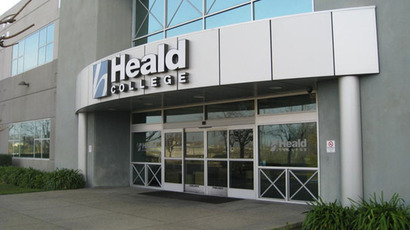'Know Before You Owe': Student loan bill would require annual counseling, updates

US Senator Chuck Grassley is set to introduce legislation that aims to boost students’ awareness of their student loan obligations and their future ability to pay back federal loans. About 17 percent of all borrowers have gone a year without payment.
Grassley (R-Iowa) said the intent of the legislation is to strengthen the Higher Education Act, a law that is likely to be reauthorized before it expires at the end of the September.
“A college education generally remains a good investment,” Grassley said in a statement.
“But when students’ academic dreams become a nightmare upon graduation because they borrowed more from the federal government than they can afford to repay with the degree they earned, they understandably feel something is wrong."
Student loan debt ($1.2 trillion) far exceeds the total all Americans owe on credit cards ($0.7 trillion) pic.twitter.com/u1IxYvvNQR
— Conrad Hackett (@conradhackett) September 12, 2015In addition to the annual counseling requirement – currently only first-time borrowers are subject to counseling – the bill would demand that higher education institutions share an estimate of a student's debt-to-income prospects following graduation, along with a warning about any potential difficulties a student may experience in repaying loans, a statement saying the student should borrow the minimum amount needed to cover costs, scholarship or work-study opportunities, and an explanation of how graduating on time would avoid further borrowing and indebtedness.
READ MORE: Popping the education bubble: White House cracks down on for-profit colleges
Students would also be required to write or type the exact amount of their federal loan, ensuring that students make “a conscious decision about how much they borrow rather than simply accepting the total amount of loans for which they are eligible,” the statement said.
The legislation would also require updated and regular loan statements to help students stay aware of their debt amount.
Grassley's bill is modeled on similar programs in his home state of Iowa.
"The federal government, as the lender, has a responsibility to at least ensure that students know what they’re getting themselves into before they get in over their heads," he said.
Students and former students in the United States have well more than $1 trillion in student loan debt. About 17 percent of borrowers, or 7 million people, have gone at least a year without making a payment on their federal student loans.
The class of 2015 is considered the most indebted class of all-time, though they will likely be superseded by the class of 2016. The average 2015 graduate with student loan debt owes more than $35,000, according to a recent analysis. About 71 percent of bachelor's degree recipients will graduate with student loan debt; that number was less than 50 percent two decades ago.
READ MORE: Disabled, unemployed woman ordered to repay student loan
“It’s unfortunate that college costs are going up and the student aid, the grants, are not going up at the same rate on a per student basis,” analyst Mark Kantrowitz, publisher at Edvisors, told the Wall Street Journal. “College is becoming less and less affordable, though it’s still just as necessary.”
Student loan payments which are seriously overdue make up about one-third of all seriously overdue debt payments in the US. Most of the colleges whose students owe the most are for-profit schools.
of top 10 colleges whose students owe most in total debt, only 2 aren't for-profit. http://t.co/9M4TVsju3e#BPEApic.twitter.com/Aqoe18UsQt
— Catherine Rampell (@crampell) September 11, 2015Median weekly earnings are nearly twice as much for those with a college degree as opposed to workers with only a high school degree, according to US Labor Department figures.
READ MORE: NYU faculty claim admin bilks students, splurges on self – report
The student loan debt crisis will likely play a part in the 2016 Republican and Democratic presidential nominations. In August, Democrat Hillary Clinton offered a plan, called the "New College Compact," to reduce student loan debt. The plan would provide $350 billion over ten years to tackle loans and increase funding for public colleges and universities.
"We need to make a quality education affordable and available to everyone willing to work for it without saddling them with decades of debt," Clinton said while unveiling her plan.
Fellow Democratic nominee Bernie Sanders has introduced legislation that would spend $70 billion per year to end undergraduate tuition and fees at public institutions, while allowing graduates to refinance loans at lower rates.
READ MORE: Presidential hopeful Senator Bernie Sanders wants free public college tuition
In 2014, Republican Marco Rubio, who has dealt with more than $100,000 of his own student debt, offered a bill in Congress that would sought to make student loan payments fit proportionally with one's income over a fixed period of time. He has also proposed alternatives to four-year colleges. He criticized Clinton's plan as more of the same.
“All that she’s talking about is ‘let’s raise taxes and let’s pour a bunch of money into a 20th-century outdated model,'” Rubio told Fox News. “This is the thing they always do on the left — she has to figure out who to raise taxes on.”
30% of millennials would sell an organ to get rid of student loan debt, they should checkout @marcorubio's plans. https://t.co/OwbBQOtxYC
— Val Mack (@Val_Mack) September 14, 2015Without ability to refinance student loan debt your plan is just rhetoric @marcorubio#FocusOnSolutions
— Carlton Sapp (@CarltonSapp) September 14, 2015Republican candidate Jeb Bush has called for a "need to change the incentives for colleges with fresh policies that result in more individualization and choices, drive down overall costs, and improve the value of a college degree, which will help lead to real, sustained four-percent economic growth."
Sen. Rand Paul has advocated for allowing borrowers to deduct the whole cost of college over an extended period of time.














